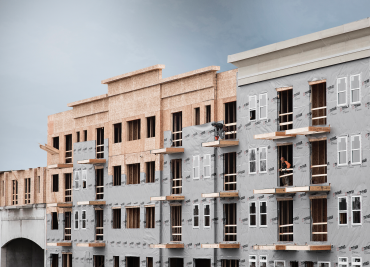
canadiancontractor
Specifying WRBs as air barriers (Sponsored Post)
An air barrier system is only as strong as its weakest link. Make sure the products you specify are tough enough to perform in the elements.
The post is sponsored by TYPAR
There are a number of materials that can achieve the air leakage requirement prescribed by ASTM E2178 for air barriers (which states that a material’s air permeance must be equal to or less than 0.02 L/(s-m2) @ 75 Pa), but will they perform in the field once installed as part of a system? Will the material be able to hold up to the rigors of the jobsite and installation? After all, an air barrier’s performance is defined by its weakest link, and it only takes one tear or unsealed connection to compromise the integrity of the entire system.
Historically, wood pulp based building paper was the most commonly used material for weather resistant barriers, but it tends to tear easily and isn’t very durable. In the 1970s, plastic building wraps made of polyethylene or polypropylene fabric began gaining in popularity for their durability and ease of installation, and remain some of the most reliable options today.
Plastic building wraps are typically either woven or non-woven—an important difference when it comes to specifying an air barrier. Woven polypropylene wraps with slit-film perforated coating typically offer two months of UV resistance, but most do not meet ASTM requirements for air barrier materials and are not surfactant resistant. Non-woven spun-bonded polypropylene with micro-porous coating, on the other hand, does meet ASTM requirements for air barriers, is resistant to surfactant chemicals and offers six months UV exposure resistance. Depending on the type of cladding that will be installed over the wrap, and how long the wrap will be exposed to the elements prior to cladding installation, these additional durability benefits may be important.
 These concerns are amplified in commercial applications. Exceptional durability is needed to handle stronger wind loads faced by taller buildings. Tear strength, as measured by trapezoidal tear tests (ASTM D-1117/ASTM D-5733), is a good measure for predicting an air barrier’s ability to stay on the wall after installation.
These concerns are amplified in commercial applications. Exceptional durability is needed to handle stronger wind loads faced by taller buildings. Tear strength, as measured by trapezoidal tear tests (ASTM D-1117/ASTM D-5733), is a good measure for predicting an air barrier’s ability to stay on the wall after installation.
Also, longer construction timelines typical of many commercial building projects put added emphasis on an air barrier’s ability to withstand extended exposure to UV light, as weeks or even months may pass before exterior cladding is installed over the building wrap. So double check how much exposure time is covered in the manufacturer’s warranty.
It’s also important to consider the type of exterior cladding that will be installed over the building wrap. Some materials, such as brick or stucco, absorb moisture that can be driven into the wall assembly by solar energy. Some cladding materials may also contain surfactant chemicals that can degrade the performance of a building wrap, so it is important to choose a material that is resistant to these chemicals to ensure sustained performance of the system.
So, as you can see, there are a number of factors that can affect the performance of an air barrier system. Make sure to do your research and understand how each component of the system will stand up to job site and elemental stresses to ensure the system performs as intended.
For more information, visit www.typar.com

Leave a Reply